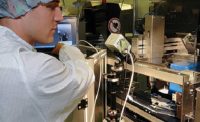In every manufacturing industry, tradition is becoming less important. Companies no longer assume that what worked in the past will be enough to keep and gain customers. Instead, they look to the latest technology to improve manufacturing processes, optimize product quality and expand their customer base.
For decades, pharmaceutical manufacturers have traditionally used dedicated machinery to fill one size or type of container (vial, syringe, IV bag). This approach is fine when producing long runs using a single type of container. But, it limits a manufacturer’s ability to package the same drug in multiple types of containers, or produce short runs for clinical trials.
Several years ago, one life science research company faced the latter situation and turned to automation specialist Automated Systems of Tacoma Inc. (AST) for help. AST, in turn, developed a customized AspetiCell to increase the company’s filling flexibility.
The AspetiCell uses one platform to handle a wide range of container types and sizes, and can be set up to switch between them in about 30 minutes. It features two Staubli TX-60 HE six-axis robots (with mounted In-Sight Micro 1100 vision systems from Cognex Corp.), and a rotary turntable that moves product through material-ingress, aseptic-processing and material-egress work areas.
The vision systems help each robot locate and fill various containers without needing them to be precisely positioned. It also enables the company to process short runs with minimal downtime.
The containers are purchased in bulk, and each comes wrapped in two sterile layers of material. An operator removes one sterile layer when the containers are brought into the clean room, and the second layer when the containers are brought into the cell.
Production begins in the material egress area, with an operator filling a large tub with rows of containers and stoppers in the upright position. After he selects an operating program using a touchscreen HMI, the tub is indexed to robot number one in the aseptic processing area. There the vision system helps the robot quickly locate each
container and fill it with nitrogen to purge it of oxygen.
After the tub is moved to the aseptic connection area and each container filled, it is moved to robot number two. This robot’s vision system acquires images of the containers and stoppers, and reports their location and type to the robot controller so it can direct the robot to select the correct end-of-arm tooling for container closing and sealing.
Different tools are used to place stoppers in vials and syringes, seal the vial stopper by crimping it with an aluminum flip-off cap, or heat-seal IV bags. Syringe stoppers are positioned by a vacuum device or mechanically pushed into place with a stainless steel straw-like tool. Once all the containers in a tub are sealed, it is moved to the material egress area and unloaded by operators.
The In-Sight Micro 1100 comes equipped with preconfigured drivers and sample code to communicate with most robots. It measures 30 by 30 by 60 millimeters and provides image resolution of 640 by 480 pixels. A nonlinear calibration tool enables it to be mounted at angles of up to 45 degrees from the object to be inspected. The system also supports Power over Ethernet to provide power and network communications on a single standard networking cable.
For more information on vision systems, call 855-426-4639 or visit www.cognex.com.



